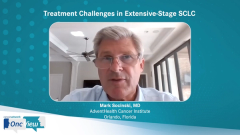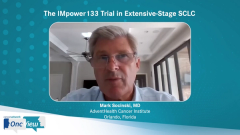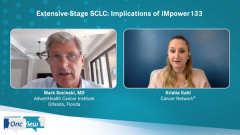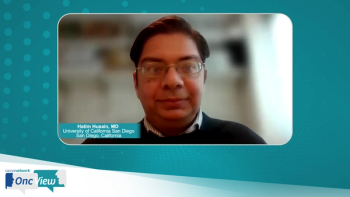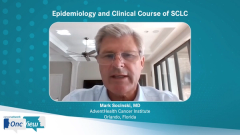
Evolution of Therapies for SCLC
Mark Socinski, MD, of AdventHealth Cancer Institute discusses his approach to treating small cell lung cancer and reacts to advances in the treatment of extensive-stage disease.
Episodes in this series

Kristie Kahl: Dr Socinski, what is the standard of care for small cell lung cancer at various stages of the disease?
Mark Socinski, MD: In limited-stage disease, the standard of care is concurrent chemoradiotherapy. This is a stage of disease when I almost always routinely use cisplatin plus etoposide with radiotherapy. We can debate the optimal radiotherapy strategy. I like twice a day and a shortened-course approach, although some radiation oncologists prefer once-daily treatments. The data suggest from a couple of clinical trials that a twice-a-day approach may be superior, but it certainly does have some logistical challenges.
As I mentioned previously, we consider limited disease to be potentially curable. And we probably cure 25% to 30% of these patients. In extensive-stage disease, we don’t consider it curable. We’ll talk a little about it here, but the standard of care for the past several decades has really not evolved until the immunotherapy era. Formerly it was basically platinum plus etoposide. There didn’t appear to be any difference between using cisplatin or carboplatin in phase 3 trials.
It’s estimated that there have been well over 30 phase 3 trials looking at new ideas in extensive-stage small cell done over the past couple of decades. None of them has really changed that standard of care. It’s remained a platform of platinum etoposide in extensive-stage disease. The expectation is that the median survival hovers just north or south of 10 months, the 1-year survival hovers just north or south of 40%. The 2-year survival is typically less than 15%. That’s where we’ve been over the past couple of decades.
Kristie Kahl: I know you mentioned where we’ve been over the past few decades. But how have treatment options evolved over the past 10 or 20 years?
Mark Socinski, MD: From a chemotherapy point of view, I would argue that they really haven’t evolved that much. We’ve been stuck with the platinum etoposide. The recent evolution, or revolution if you call it that, has been integration of immunotherapy in this setting. We’ll talk about that in a moment. That’s been the significant change in the standard of care, but that’s only been over the past couple of years.
Kristie Kahl: What have we learned about predictive factors for treatment response? For example, does biomarker testing play a role in the treatment decision-making?
Mark Socinski, MD: Unfortunately, we don’t have any predictive markers for treatment response. And we don’t really do any significant biomarker testing. Not even PD-L1 testing is routinely done. As I mentioned, this is a disease in which there are no targetable oncogenic driver alterations. Most of the alterations are in tumor suppressor genes, which are difficult if not impossible to target. There has been a paucity and a lack of biomarker availability and biomarker usefulness in this particular setting. We still don’t have good predictive factors for who’s going to respond well and who’s not.
Transcript edited for clarity.
Newsletter
Stay up to date on recent advances in the multidisciplinary approach to cancer.



